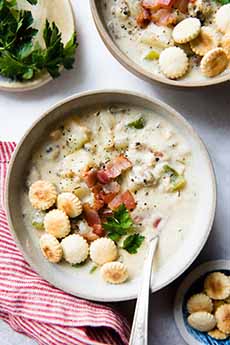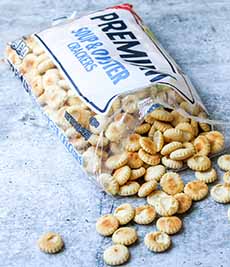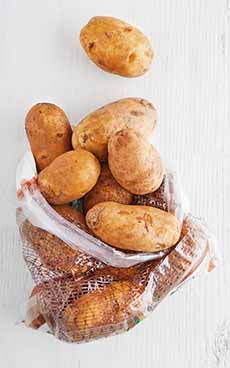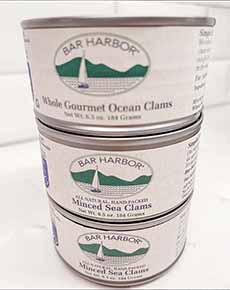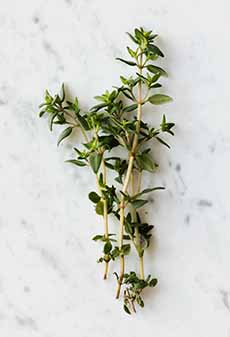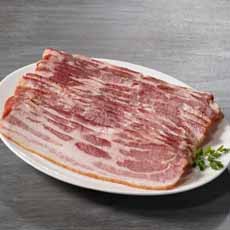Clam Chowder Recipes For National Clam Chowder Day
|
|
For February 25th, National Clam Chowder, we made the delicious Instant Pot Clam Chowder recipe that follows (photo #1). > The history of clam chowder is below. > So are more chowder recipes. > The different types of soup: a delicious photo glossary. > The history of soup. 1. CHOP the potatoes into 1-inch chunks. Soak them in cold water and set aside. 2. TURN the Instant Pot to the sauté function. Add 1/2 tablespoon olive oil to the pot. 3. TRANSFER the diced bacon to the Instant Pot and cook for 3 to 4 minutes, stirring occasionally. Carefully transfer the cooked bacon to a plate, leaving the rendered bacon fat in the pot. 4. ADD another 1/2 tablespoon of olive oil and the diced onions. Cook the onions for 3 minutes and then add the garlic. Sauté everything for another minute, stirring occasionally. 5. DRAIN the potatoes and add them to the Instant Pot. Add the clams, clam juice, water, thyme and salt. Secure the lid on the pot and cook everything on high for 5 minutes. 6. MANUALLY RELEASE the pressure by moving the valve to venting. Remove the lid and turn switch to the sauté function once again. 7. ADD the cooked bacon, diced celery, cream and milk. Bring everything to boil. 8. ADD the flour to a small bowl. Ladle about 3/4 cup of the liquid from the soup and transfer it to the bowl. Using a fork, stir the flour and liquid together until you get a thick paste. Scrape the thick paste into the Instant Pot and stir to incorporate with the rest of the soup. 9. LET the soup simmer for about 4 minutes and turn off the Instant Pot. Serve the soup in bowls. Garnish with black pepper, parsley and crackers, if desired. Fish chowder was commonly made on fishing vessels from pre-Colonial times (and likely, since the dawn of fishing vessels). Fisherman sustained themselves with part of their catch. The origins of clam chowder can be traced back to the early days of European settlement in North America. It’s believed that French and British settlers brought the concept of fish and shellfish soups to the New England area. The word chowder itself is thought to have originated from the French word chaudière, which refers to a large cooking pot. New England Clam Chowder. This creamy and milky chowder, sometimes called white clam chowder (like the recipe above) became popular in the 18th and 19th centuries. Early recipes for clam chowder often included ingredients such as clams, salt pork, onions, and potatoes. Today, bacon usually replaces the salt pork. The use of dairy, particularly milk or cream, gives the soup the rich and creamy consistency that distinguishes it from other types of chowder. Manhattan Clam Chowder. In the early 20th century, a tomato-based version of clam chowder gained popularity in Manhattan and became known as Manhattan clam chowder. It includes tomatoes, vegetables, and sometimes a clear broth. The two parent chowders are typically cooked separately before being poured into the same pot or bowl. Clam chowder—either recipe—has become a beloved dish in American cuisine, and a culinary symbol in coastal communities, especially in the northeastern U.S. While New England and Manhattan clam chowders are the most well-known, variations exist throughout the country. Some regions may incorporate local ingredients, spices, or different types of seafood to create their unique twist on the classic recipe. For example, Rhode Island Clam Chowder is made with clear broth made with neither dairy nor tomatoes. Today, clam chowder is enjoyed in restaurants and homes across the U.S. (and beyond). Its rich, comfort food flavors make it a timeless classic in American cuisine. CHECK OUT WHAT’S HAPPENING ON OUR HOME PAGE, THENIBBLE.COM. |
|
|
|
||
